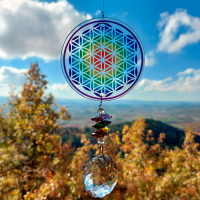The sacred geometry of cathedrals

Sacred geometry in architecture: cathedrals
One of the primary requirements for a shrine, as a cathedral can be, has always been a well-proportioned architecture, a good location and a good orientation.
Orientation remains a key issue for sacred geometry in architecture : the mosque faces Mecca, while most Hindu and Christian temples face east. There are a few exceptions, such as Chartres Cathedral in France, which faces northeast.
In the past, churches, temples and megalithic stones had to be erected on a powerful site. In imperial China, and still today, Feng Shui is used to find the hsueh, or dragon point, to bring the most energy to important buildings, such as palaces, mums, temples and tombs.
In its early days, the Christian church even drew up guidelines which, if necessary, required that churches be built on ancient pagan places of worship
There were 3 reasons for this: the geometric priests used the power of the places, the followers of the ancient cults continued to come there, and the original pagan artifacts were destroyed. The applications derived from this become interesting if one observes the geometry of the meridian lines. Finally, the structure, equally important, had to meet certain precise geometrical rules.
Geometry and numbers are sacred because they codify the hidden order of creation. They are the instruments that served the genesis of the universe. The simplicity of numbers, fractions and proportions makes the universe and the geometry of Euclid and the Greeks rigorous and harmonious.
A place becomes sacred when the dimensions in which it is built depend on proportions that are either whole numbers or specific numbers, such as the golden ratio. These shrines are harmonious and have certain temple-like qualities.
As Christianity spread throughout Europe, the construction of imposing cathedrals became an outward expression of reverence for the divine, as well as a focal point of community life for centuries. Construction often took more than a century, inspiring generations to be a part of something greater than the individual.
Let's take a look at four architectural ensembles that have left their mark on history through their beauty and their architecture structured around the golden ratio.
The sacred geometry of the Notre-Dame de Paris cathedral
The construction of one of the most beautiful remaining cathedrals in Paris began in 1963 under the direction of Bishop Maurice de Sully, who died in 1996. The construction of the western façade was completed in 1225. Another century passed before the cathedral was completed. Some 850 years later, it is one of the biggest tourist attractions in Paris. Interestingly, the dimensions of the western façade, as well as the gothic rose window facing north, reflect the golden ratio.

The proportions of the floor plan of Paris are also directed by golden rectangles.
As a reminder, the golden rectangle is a rectangle whose length is average proportional between the width and the half perimeter. The golden ratio is the proportion thus defined and is represented by the Greek letter phi (φ)

The rose windows of Notre-Dame Cathedral
The north and south rose windows of Notre-Dame Cathedral in Paris show the divine proportion in a magnificent way.


The sacred geometry of the Notre-Dame de Chartres cathedral

Shortly after the construction of Notre Dame in Paris began, another cathedral was built in Chartres, 80 km southwest of Paris. It was completed around 1220 and, as with Notre-Dame de Paris, has golden proportions. In fact, the golden ratio seems to reappear in various cathedrals throughout Europe.
The geometry of Chartres Cathedral's buttresses, which support the weight of the stone vaults, use circles and vesica pisces.
Chartres is known to be a magical cathedral, with a strong energy, black virgins and ... a labyrinth!
The Chartres labyrinth, dating from the 12th century, is a circular geometrical figure of 12.89 m in diameter inscribed in the entire width of the paving of the main nave, between the third and fourth bays
Chartres is the only cathedral whose floor is still decorated with a labyrinth. The tradition of drawing labyrinths on the floors of churches is very old
At the time of the crusades, between the 11th and 12th centuries, labyrinths were used as a substitute for pilgrimages to Jerusalem. They were even called the roads to Jerusalem. Christians, unable to go to Jerusalem, walked the labyrinth on their knees in penance
There is something magical about cathedrals, built specifically to allow visitors to feel energy, to get closer to the spiritual but also to cleanse themselves. The Labyrinth located on a specific point will allow a kind of journey. It will cleanse you of negative energies but also center you. It will lead you inside yourself, allowing you to get closer to a consciousness. In short: to simply elevate yourself.
Symbolically, the labyrinth unites heaven and earth, it represents a long path full of pitfalls, a journey of multiple states of being where the being wanders before finding the center. It is above all an inner journey where you will find your center.

Vibratory rate of the Chartres labyrinth
Some testimonies indicate that all around the labyrinth there is a vibration of 6500 units, which is nothing special, but as soon as you enter the lines of the labyrinth you are bathed in a balancing vibration of 8000. Inside the loop, where the local magnetic field could amplify the rhythm of the walk, one is brought to the vibratory level of the etheric body at 13,500 units.
And, no need to remind it but the labyrinth is above all... a mandala!
Powerful telluric center
Chartres Cathedral is known to be an extremely powerful place energetically.
It was built on a famous place of worship from the time of the Druids. The geo-biological support and the construction of the building is a water current located at a depth of 37 m. For the sake of energy balance, the backbone of the vaults was placed at 37 m height. The altar is placed in the geometric centre of the rounded chevet and the ambulatory at the meeting point of 14 underground water currents symbolised by 7 doves with 2 beaks.
In the central aisle, the arrangement of white and black stones draws an immense labyrinth. This labyrinth is a powerful regenerator. No less than five streams of water, plus a rift, meet at this point.
The cathedral was built from a telluric center well known to the Celts; a column from which everything started and which makes the link between the world above and the world below; the cathedral starts from a sacred center or head of the vouivre, this column determines the enclosure of the sacred place.
At the origin of the sanctuary, the primitive sacred enclosure was equipped with a well. It is purifying and "harmonizing" and plays its role of regulator by grounding cosmic and telluric emergences. Today the well is condemned, but it was once renowned for its miraculous water.
The sacred geometry of Milan Cathedral

The construction of the cathedral of Milan was long, with many modifications and many new plans.
The plans published in 1521 by the architect Cesar Caesariano are often cited in works on sacred geometry, but they remain theoretical and were never put into practice. The present form of the dome of Milan does not correspond to these plans, except for some basic elements, such as the number of doors. Nevertheless, these plans allow us to glimpse the methods used by the architects of the time.


The first thing one notices are the triangular lines drawn by the pinnacle of the tower, which, according to some authors, indicates that it is an ad triangulum design, thus inspired by the triangle. This is in fact not the case, and the spires of the cathedral's façade are designed according to a series of concentric circles, spaced at 14 units.
Note: Caesariano indicates two scales at the top of his plan but does not specify the units.
The coefficients of the Milan cathedral are 7, not phi as some may say.
The sacred geometry of the cathedral of Santa Maria del Fiore in Florence

And finally, let's take a look at one of the other most famous and recognizable architectural wonders in the world: the Cathedral of Santa Maria del Fiore in Florence, whose construction began in 1296.
The Cathedral or Duomo of Florence as we see it today is the result of a long work that spanned more than six centuries of history. The basic architectural plan was designed by Arnolfo di Cambio at the end of the 13th century; the dome, which has become a symbol for the whole of Tuscany, is the work of the Renaissance genius, Filippo Brunelleschi, while the facade completing the building was only completed at the end of the 19th century.
In addition to being an engineering masterpiece, Brunelleschi's famous octagonal dome displays golden proportions. The golden ratio can be seen in many elements of the cathedral's final floor plan.
If the cathedral is known for its architecture, so are its interior pavements.


The Symbolism of Rose windows in Cathedrals
A rosette is a symmetrical geometric figure, formed of curves inscribed in a circle from a central point or knob, having more or less the shape of a rose or a stylized star.
Widely used in the architecture of churches, but also in mosques, steles in ancient Egypt, synagogues, for example, its symbolism is traditionally a bearer of the mystery of life, death, love and eternity.
The rose window is a solar symbol that emits very powerful cosmic vibrations in cathedrals. Here again, we find in these magnificent works a centre whose motif will define the whole rose window and its meaning.
For some, the rose window is the ancient symbol of the flower of life. Often present in the stained glass windows of cathedrals and churches, it evokes the sun and the divinity, but also the cycle of life.
The cathedral is like an open book. The rose is an essential chapter. It offers to read a major and unavoidable element of universal symbolism
Moreover, the origin of the round window is the oculus (eye) of ancient Rome, whose symbolism was solar
When we cross the threshold of the cathedral, everything is dark, which immediately puts us in a collected and silent feeling. We are then attracted by the light that grows as we move through the nave. When we reach the transept, we turn towards the source of this light and we see before our eyes the luminous, brilliant splendour of the rose windows.
We experience a kind of enchantment, awe, the first time and every time we see these roses - these rosettes
When Thomas Aquinas saw the rosettes of Notre Dame Cathedral in Paris under construction while he was a professor of theology at the Sorbonne in the years 1250-1260, he saw in them the embodiment of the three qualities of beauty as he defined them: integritas (integrity, completeness, uniqueness), consonantia (harmony, proportion, agreement), and claritas (brightness, radiance). The rosettes possess these three qualities in that nothing essential is missing, nothing superfluous is intermingled (integritas); they are in accord and harmony with their ultimate transcendent purpose (consonantia); and they manifest the essential reality that is God through their radiant brilliance and splendour (claritas). Their beauty, their purity, their harmony are directed to a higher good (Source: Aleteia.org).
Alchemy and cathedrals
The medieval cathedrals are comparable to atomic crushers where beneficial powers are concentrated and whose permanence is maintained by the rites. The same analysis has been made by Egyptologists about the Pharaonic temples. There again, the same science, the same tradition. In fact, the cathedral receives cosmic energy and redistributes it
The cathedrals were built to reflect the harmony of the cosmos where everything is carefully ordered. They were built according to the Divine Proportion, which also governed the formation of the human body. Now, every church is the body of Christ, considered not as an individual, but as man in the measure of the universe, which gathers in him all the expressions of creation.
The cathedral is not just a simple representation of the Universe, but, through the rite that takes place around the altar, it becomes a space of communication between man and the cosmic principles. Because it is comparable to an atomic crusher where beneficial powers are concentrated and whose permanence is maintained by rites.
The same analysis has been made by Egyptologists about the Pharaonic temples. In fact, the cathedral, because of all the parameters used, receives the cosmic energy and redistributes it. But it is also a space of transfiguration since it is able to transform the profane into the sacred
The cathedrals, just like the symbols of sacred geometry, are tools, representations, to straighten us and make us aware of ourselves.
I hope you enjoyed this article
Feel free to comment, share and subscribe to our newsletter to be informed of future releases.
Sources:
Géométrie sacrée (Vega Publishing)
The Golden Number (Dervy Publishing)














 Christmas Tree Star: The True Meaning
Christmas Tree Star: The True Meaning
 Meaning of the Infinity Symbol: A Journey Toward Eternity
Meaning of the Infinity Symbol: A Journey Toward Eternity
 Symbolism of the circle: the mystery of a perfect shape
Symbolism of the circle: the mystery of a perfect shape
 Healthy mind in a healthy body: regaining balance
Healthy mind in a healthy body: regaining balance
 Flower of Life Mandala: a daily Art of living
Flower of Life Mandala: a daily Art of living